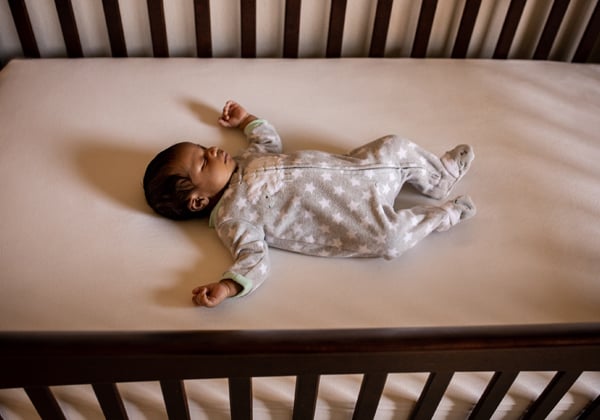Use a firm and flat sleep surface.

Additional Info
Learn More
A firm surface means that it shouldn’t indent when your baby is lying on it. Any surface that inclines more than 10 degrees isn’t safe for your baby to sleep on.
- Place your baby in a crib, bassinet, portable crib or play yard that meets the safety standards of the Consumer Product Safety Commission (CPSC).
- Check the CPSC website to make sure your crib hasn’t been recalled, especially if it’s not new.
- Make sure your crib mattress is designed for your specific crib and that it fits tightly. Use a fitted sheet only—nothing else should be in the crib with your baby.
- Don’t use a crib that doesn’t have instructions, is missing hardware or that’s broken.
- Alternative sleep surfaces are only considered a safe option if they comply with the June 2021 CPSC rule that all infant sleep products must meet the existing federal safety standards for cribs, bassinets, portable cribs or play yards. This includes inclined sleep products, hammocks, baby boxes, in-bed sleepers, baby nests and pods, compact bassinets, travel bassinets and baby tents. If a product doesn’t meet federal safety standards, avoid it.
- If your baby falls asleep in a car seat, stroller, swing, infant carrier or sling, you should move them to a firm sleep surface on their back as soon as possible.
- Don’t use products for sleep that aren’t specifically marketed for infant sleep. Examples include Boppy pillows and Dock-a-Tots.
- In an emergency, you can temporarily put your baby to sleep in a box, basket, dresser drawer or something similar. It should have thin, firm padding. As soon as you can get a CPSC-approved sleep surface, move your baby to that instead.
- If you need financial help, there are organizations throughout the United States that provide low-cost or free sleep surfaces. Check with your local Social Services agency.
Click HERE to learn about where your baby should and should not sleep, so you can make the best choice for you and your baby.
Common Questions
No. You might think that the mattress in your crib or the pad in your portable crib is too hard, but these firm surfaces are just right for your baby. Only add a fitted sheet. Nothing more. Don’t try to make it soft or more comfy for your baby. Soft surfaces are very dangerous for babies because they increase the risk of suffocation.
Sitting devices, such as car seats, strollers, swings, and infant carriers are not recommended for routine sleep. Infants do not have much control of their heads and necks. When your baby is sleeping in an inclined seat his/her head can fall forward which can make it difficult to breathe, resulting in positional asphyxiation.
When your infant is in their car seat in the car the car seats inclines, but when out of the car base they do not incline as much—making them risky places to sleep. When you get home, you should always take your baby out of the car seat whether he/she is sleeping or not.
Also let your family and daycare provider know that you don’t want your baby sleeping in the car seat or other sitting device.
